#antique indigo fabric
Text

Antique indigo fabric from the Port Vanves brocante in Paris. 2 large pieces that would've once been used to make work wear and the famous blue aprons.
#brocante#decor#sewing#shabby#mdmefroufrou#antique#antique french fabric#antique indigo fabric#indigo blue#aprons#work wear
9 notes
·
View notes
Text



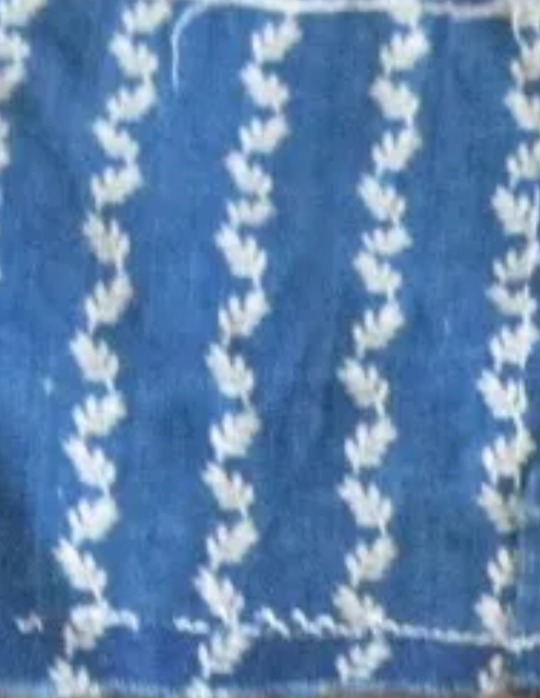






3 notes
·
View notes
Text
British ships carrying plants and seeds from around the world arrived in Botany Bay on January 20 1788. This story is overshadowed by convict ships and Royal Navy vessels, but the cargo on board also had a lasting impact. Colonists, convicts and Indigenous Australians were all affected [...]. Some of these plants [...] were food sources [...]. Others were attempts to expand the British Empire. Could the new territory be exploited as a tropical plantation? In the parliamentary debate over destinations for convict transportation [considering potential locations for sending prisoners], Sir Joseph Banks and James Matra, both members of James Cook’s 1770 expedition [to the South Pacific], spruiked the potential of the new colony as an extension of the empire. Matra claimed the colony was “fitted for production” of “sugar-cane, tea, coffee, silk, cotton, indigo and tobacco”. Banks claimed Botany Bay was an “advantageous” site, with fertile soil [...].
Two plants carried by the First Fleet stand out as examples of botanical imperialism: prickly pear cactus (Opuntia) and sugarcane.
Banks, as head of the Royal Society of London [and as a close adviser to King George, and also as a plant-collecting botanist who turned the Royal Botanic Gardens at Kew in London into the world's leading botanical garden], selected these species as experiments to compete with European trade rivals. His goal was to break a Spanish monopoly in producing fabric dye and to expand British cultivation of sugar outside the West Indies.
Prickly pear cactus was imported because it is the preferred food of the cochineal insect.
Dried cochineal were crushed to make a vibrant, colourfast scarlet dye for textiles. Discovered in the New World by Spanish colonists, cochineal replaced kermes, another insect that had provided red dye since antiquity. Cochineal dye was ten times stronger than kermes or vegetable dyes.
From cardinals’ capes to British officers’ red coats, cochineal was a product for elite consumers signifying power, wealth and prestige.
New Spain, based in Mexico, had a monopoly on cochineal. Banks wanted to break the stranglehold on the scarlet dye by establishing production in New South Wales.
Plants infested with the precious insects were imported from Brazil in 1788. The project soon failed when the cochineal died, but the cacti survived. Colonists used cacti as natural fences and drought-resistant animal fodder.
Without insects to feed on them the plants spread, uncontrolled, to cover more than 60 million acres of eastern Australia by the 1920s. Poison, crushing and fire failed to stop the cactus. [...] Opuntia cacti remain an environmental hazard. [...] The roots of these early imperial projects are deeply embedded in Australian culture and history, with an enduring legacy.
---
Text above by: Garritt C. Van Dyk. "The botanical imperialism of weeds and crops: how alien plant species on the First Fleet changed Australia". The Conversation. 25 January 2024. [Italicized text within brackets added by me. Some paragraph breaks/contractions added by me.]
87 notes
·
View notes
Text
白いビンテージ
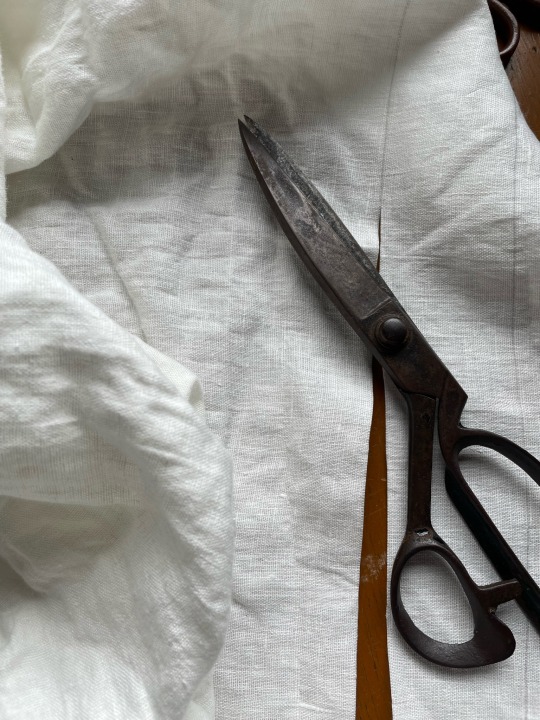
白い服が好きです。畑仕事に絵描き、汚れることばかりしているのに白い服が好きです。
うっかりしてよくコーヒーなどをこぼすのに白い服が好きです。
改まった新品の白もいいけれど、古い白の布が好きなのです。
色がない分、糸の表情が際立つからでしょうか。
昔の日本では作業着を藍で染めました。防虫効果が高いからです。また、昔の日本では商人、武士、職人以外のほとんどの人は農民だったため、普段着=作業着でした。
日常着=作業着というのはどの国でもそうであったのかと思います。
各国や民族の服は、歴史を辿ればたどるほど面白いです。中でも惹かれるのはフランスの作業着。
作業着なのにこんなにもギャザーを寄せる必要はあったのでしょうか?気が遠くなるほど細かく美しい手作業に惚れ惚れします。
大好きな白と作業着。好きにならないわけはありません。
all the time.
I like white clothes even though I often accidentally spill coffee and other things on them.
I like old white fabrics as much as I like new white fabrics.
Perhaps it is because the absence of color makes the threads stand out.
In old Japan, work clothes were dyed with indigo. This was because it was highly effective in repelling insects. Also, in olden times, most people in Japan were farmers, except for merchants, warriors, and craftsmen, so their everyday clothes were work clothes.
I think it was the same in all countries where daily clothes = work clothes.
The more one traces the history of clothing of different countries and ethnic groups, the more interesting it becomes. I am particularly fascinated by French work clothes.
Was it necessary to gather so much for work clothes? I am in love with the beautiful handwork that is so detailed and beautiful that it makes me feel faint.
My favorite white and work clothes. I love white and work clothes, what's not to love?
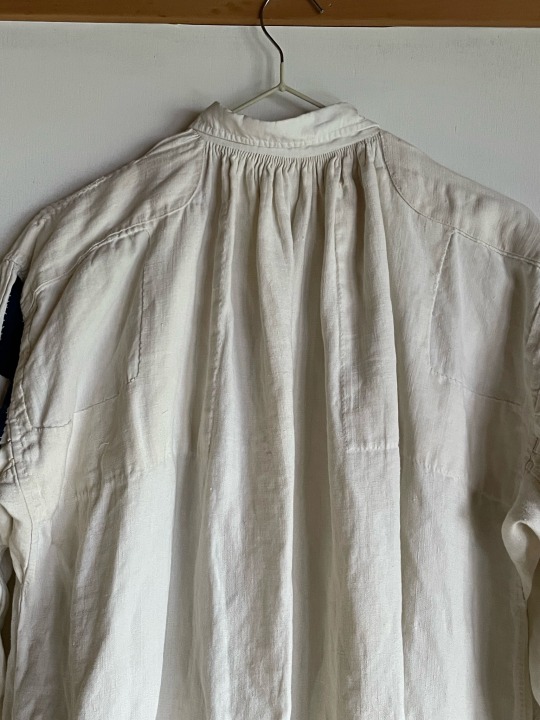
毎日着るものだからこそこだわったのかもしれません。
白とネイビーは相性抜群。
同じ時代の日本とフランスの布を合わせて、ボロボロだったところをリペアします。
シーツとして使われていたアンティークの白いリネンと、日本の古い格子模様の浴衣の生地を合わせてエプロンドレスを作りました。もちろん、フレンチビンテージウェアのようにたっぷりのギャザーを寄せて。
日本の浴衣=パジャマ。藍で染めていないものも多くあります。
Perhaps it is because it is something you wear every day that you were particular about it.
White and navy go well together.
Japanese and French fabrics from the same period are matched and repaired where they were tattered.
Antique white linen used as sheets and old Japanese plaid yukata fabric were combined to make an apron dress. Of course, it was gathered generously like French vintage wear.
Japanese yukata = pajamas. Many are not dyed with indigo.
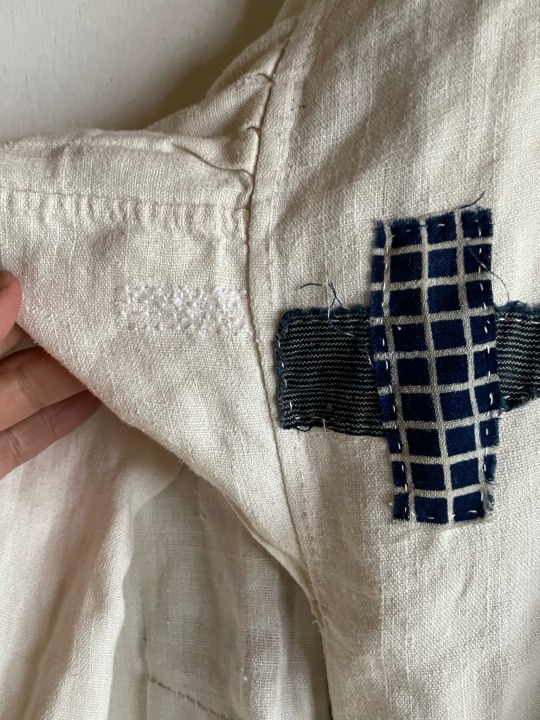
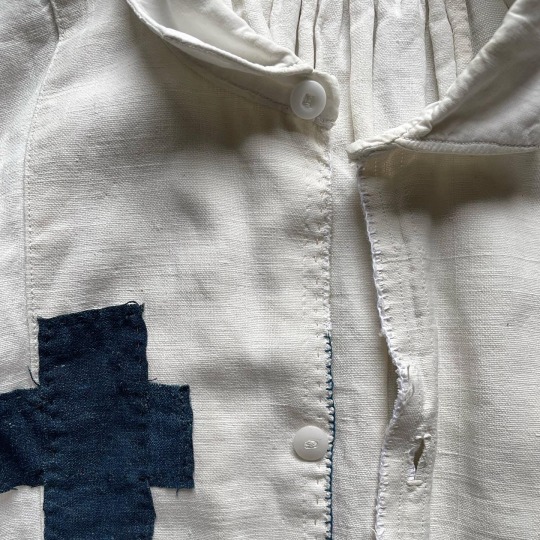

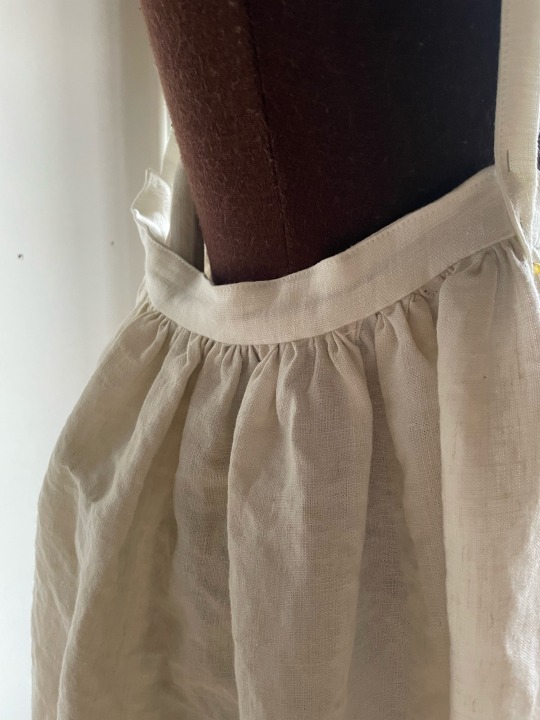

最近では古着のTシャツやデニム、軍パンなどカジュアルな装いにさらっと合わせて着たい気分です。
自分用にも1着は取っておこう。
Recently, I am in the mood to wear it with casual outfits such as old T-shirts, denim, and military pants.
I'll keep one for myself.
#visible mending#boro#japanese boro#noragi#sashiko#patchwork#sustainable#french vintage#farmer style#apron dress
28 notes
·
View notes
Text

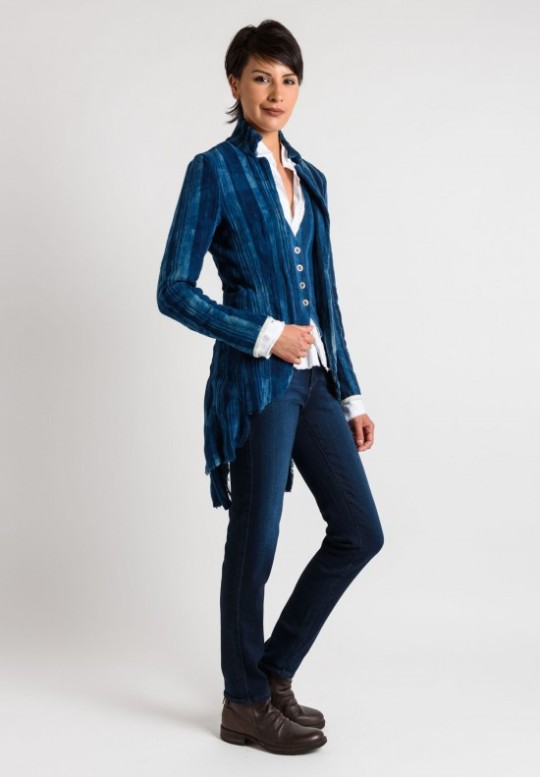

Greg Lauren Long Antique Jacket in Indigo
Made From Vintage African Indigo Fabric
6 notes
·
View notes
Photo
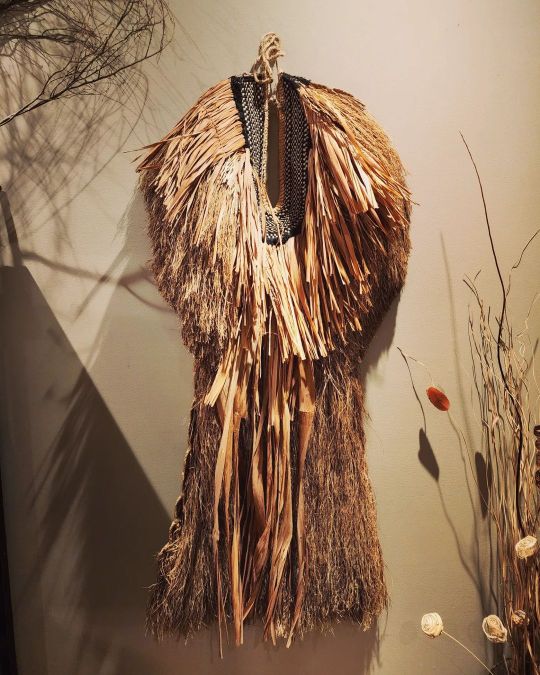
Vintage Mino straw cape from mid-century Japan. A traditional raincoat made out of straw. Rice straw & other bast fibers have natural water-resistant properties & help with repellent rain droplets. When the rain droplets hit the surface of the straw cape, the water tends to flow along the length of the fibers above and helps keep the underneath garment staying dry. Peasants would often wear this while working in the rain out in the field. It is light in weight and could also be used as camouflage in certain terrain. These particular straw capes were woven beautifully on the back side. Some designs would have the addition weaven of indigo-dyed fabric straps. The bast fibers used here seem to be perhaps some type of rice straw. It was handmade and woven by the Northern people in Aizu. It would then be often used when they go into the mountains for foraging. A wonderful handmade piece of old folk garment symbolizing the country life in old rural Japan. #wabisabi #artpiece #vintagefashion #visvim #boro #Kapital #japaneseclothes #boroboro #downtownsquamish #vintage #antiques #museumgallery #japanesevintage #vintageindigo #patchwork #japaneseboro #japanesetextile #sashiko #costume #naturedyed #streetwear #cosplay #folkart #fashionweek #rustic #porterclassic #rrl #shogun #Mukashinoboro (at Squamish, British Columbia) https://www.instagram.com/p/Cod5jQ_rh09/?igshid=NGJjMDIxMWI=
#wabisabi#artpiece#vintagefashion#visvim#boro#kapital#japaneseclothes#boroboro#downtownsquamish#vintage#antiques#museumgallery#japanesevintage#vintageindigo#patchwork#japaneseboro#japanesetextile#sashiko#costume#naturedyed#streetwear#cosplay#folkart#fashionweek#rustic#porterclassic#rrl#shogun#mukashinoboro
14 notes
·
View notes
Text
ROY G BIV Tag Game
Rules: Find the seven colors of the rainbow in your WIPs. (For Cavernous)
ooh! This game is cute - thanks to @antique-symbolism for tagging me <3
RED
No one else was there, save for an old woman at a forge and bellows, sorting through a set of metalworking tools. Her foundry sat at the far side of the plaza, decorated with terracotta tilework. The whole avenue was painted in reds and ochres, with yellow mushrooms sprouting up between the street cobbles, and a towering stalagmite with a stone awning built around it at the center.
ORANGE
It took a second for her to gain her bearings in the darkness, streams of water trickling down around her in every direction. She saw a flash of orange - Joanna’s helmet.
Then --
-- a CRACK. Loud enough that she felt it. One of the metal struts bowed out across the tunnel, bent in half. The slabs of rock above her seemed like they were shifting. Breathing. The ceiling was coming down.
YELLOW
When he turned around Tatiana was right behind him, halfway out the door and eye-to-eye with him under the yellow porch lights even though she stood two steps higher than him on the stoop. A couple of moths fluttered around the doorway as it creaked closed behind her and a chorus of crickets filled the cool dusk.
This is getting long so the rest is under the cut!
GREEN

Girl help how do i pick ????? UM
She watched him with amusement as he returned to assembling a folding table for his beloved rock saw, his various microscopes, and sample trays. All the while ,he was wearing a gift-shop novelty t-shirt with a triceratops on it - photosensitive so that each time he stepped into the sun, the dinosaur turned bright green. The shirt was enormous on him, and hung off his slight frame. If not for his five-o’clock-shadow, he would have looked like a tall child in pajamas.
Stacker’s villa was small, cut into a block of reddish limestone, large enough for only a few rooms despite its two stories, with a veranda and a garden around the back. Its rooftop was crowned with dark green mosses and rotund stalagmites blackened by the smoke coming from the chimney. To Carmen, it was the most enchanting little house she’d ever seen.
BLUE
She exhaled, finally, and shot a look at Irina. She was surprised to find her staring, not at the city, but directly upwards. Above them, the cave ceiling was alight with brilliant specks of blue. At first, it looked like stars, and Joanna blinked back her confusion before realizing it was bioluminescence - fungi and larvae teeming over the rock, emitting enough light that their headlamps were pointless.
INDIGO I have a teal though! With some bonus blues.
Next he sorted out all the blues, grays and teal colors for Carmen, holding the fabrics near her face first to examine, then discarding some of the darker colors.
“For you, little one,” he said, finally picking out a breezy sheer caftan in a baby blue, “We must remain understated.”
VIOLET nah, purple :)
At the lowest tier of the rotunda was a sunken round, lined with cushions and silk throws. A small gathering of patrons lounged there, two of the women wrapped up in an embrace, hands all over one another. A lithe young man amidst them reached hand up one of the woman's thighs as she put her teeth to her partner’s neck. He wore the same wine-purple robe as the woman who had welcomed them at the door.
Taglist: @ultimatecryptid @kainablue @asher-writes @saraheadriance @maxgraybooks @thelaughingstag @artbyeloquent @ellierenae @calico-fiction @wildswrites @galaxy-writer @raisapathy @astridmayewrites @antique-symbolism-main @crazybunchwriting
6 notes
·
View notes
Link
Check out this listing I just added to my Poshmark closet: SOLD! Wrangler Relaxed Fit Jeans SEE Size Tag 50x34 ALTERED ACTUAL 50x26.
0 notes
Text



Indigo Dyed Series
(UpcycleLino) Indigo Dyed Linen Cotton Lace Band Collar Pullover Shirt
https://en.nestrobe.com/itemdetail?ItemID=02231-0015
An antique inspired band collar pullover shirt from our indigo dyed series, featuring a unique geometric patterned cotton lace along the front placket. Crafted from our plain weave sustainable fabric from a single strand of lightweight linen warp yarn and heavy weight cotton-linen blend of our upcycled weft yarn. UpcycleLino yarns and fabrics are slow made in Japan which can only be produced by our expert craftsmen from leftovers of our garment production. This sustainable fabric has been indigo dyed giving the garment its unique hue that will gradually wear and age better over time.
ONLINE STORE
https://en.nestrobe.com/
0 notes
Link
Check out this listing I just added to my Poshmark closet: Vintage Y2K Indigo Moon Pink Oversized Blazer Jacket Rare.
0 notes
Text
Let the Light in With Closet Curtains

Closet curtains bring a unique, decorative touch to any room in your modern house. As closet door replacement, you can choose either drapes or sheer. With the sheer variety, you get an airy, light and billowy feel. However, the design does not have much to give when it comes to protecting your privacy unlike with drapes that fall back in place every time you open it.
Beaded curtains are another unique design to consider. They are stylish and perfect for use in your children's room. With curtains as your closet cover, you do not have to worry that your child will accidentally lock himself inside the closet or bang his head on the door or close the door on his hand. Here are some examples of closet curtains from online retailers (Amazon, jcpenney.com, etc).
Beaded Curtain, Raindrops Pink Iridescent:
The strands of this beaded curtain are attached to one rod and ready to hang. The heavy-duty acrylic beads have beautiful iridescent coating, making the curtain perfect for use in almost all rooms in your house, including bedroom, pantry and laundry. The sparkling look of the gem can be mesmerizing and attractive. The available sizes are 35 inches in width by 70 inches in length. You can shop this beaded curtain for a retail price of $18.99.
Shari II Lace Door Panel:
This soft, subtle yet elegant lace curtains can bring an element of romance into your home. This curtain, which is part of the JCPenney Home Collection, uses a lace of scalloped polyester jacquard. It features shirr on its 1-inch clear rod. Available sizes are 45 inches in width by 45 inches in length and 45 inches in width by 80 inches in length. Color options are cool white, dusty mauve, antique bronze, linen and rich burgundy. Sale prices range from $6.99 to $11.99.
Linden Street Sheer Door Panel:
These sheer but thick drapes help block excess light from going into the area it encloses, thus giving your room that airy and light feeling. You have a choice of two styles and many colors, including green clay, chocolate, desert khaki, cinnamon brandy, light indigo, lake mist, Stonehenge, rustic red, toffee and soft cream. It measures 54 inches in width and 72 inches in length. It sells for a discounted price of $14.99.
PVC Door Curtain:
This door curtain is easy to install. It helps reduce draught, welding flash, dust, noise and spray. Available grades are standard, polar, ribbed and welding quality while the standard sizes are 200x2x50 meters, 300x2x50 meters, 300x3x50 meters, 400x4x50 meters, 1000x2x20 meters, 1000x3x20 meters and 1000x5x20 meters. Colors available are green, red and bronze. Know more here fabric ducting material
Classic Check Door Panel by Waverly:
This windowpane plaid Linden door panel has a Velcro which is used to attach to the door. You can use the Velcro tabs to fold or roll and secure the door panel in place. The material is washable cotton and comes in color choices of crimson, sage, black, dark chocolate and marine blue. It measures 26 inches wide by 68 inches long. You can buy this door panel at jcpenney.com for $35.99.
1 note
·
View note
Text
Roman Textiles: An Overview
Textiles were a critical part of culture and economic activity during the Roman Period. From managing the line between the social classes to being a major commodity, textiles did it all as they were not perishable unlike food and were easy to display on one’s body unlike money. Such a unique intersection resulted in textiles being one of the earliest industries to have high amounts of specialization for each step of production and be an early indicator of spreading ideas, in which the new techniques for textiles arrive first. As such, there has been an increase in interest in how the Romans related to textiles in Classical Antiquity as a way to look deeper into Roman life and potentially see some of ourselves looking back.

The two most common textiles in the Mediterranean were linen and wool as the western and northern parts of the empire produced wool in un-arable land and, in the eastern parts, the dry climate makes flax cultivation easy. This does not mean that they did not have other textiles. Only other types came from external sources, namely: cotton from India and silk from China.
Wool is relatively simple in which the fleece is removed from the sheep then is cleaned, washed, and sorted by size in order to properly organize the wool for spinning.
On the other hand, linen takes a few more steps. Once the flax plant is ready the stalks are collected and are retted which involves soaking the stem in order to break off the layers around the fibers inside. Then it is dried which then leads into scutching, in which the fibers are pressed in a way to remove the impurities such as the woody stem. Afterwards it is heckled which is combing the fibers to sort them by fineness and size.
Once the fibers or fleece are collected, they would then be spun into thread by a spindle whorl which was a task typically done by women. This often means that it was not too unusual to see Roman women walking around spinning thread as they used a drop spindle. Often only the flat part of the spindle survives archaeologically with a hole in the middle for a stick to be pushed through as a way to adjust the balance. Different regions have different tendencies in spin direction which resulted in items spun in wool regions to be Z spun while S spun in flax regions as flax has a tendency towards that direction. (Image provided to show the difference.)

Once the thread is spun, there comes a split in the path depending on the goals for the final textile in regard to dyeing the thread or the final woven fabric. On dyeing, there were only a limited number of colors available to the Romans and, in order to produce more, one must mix them to cover gaps in colorants. This dye cannon did not change much for a long time in the region until the production of synthetic dyes by chemists in the 19th century. The core colors were red, blue, yellow, and purple in which most colors are from a combination of these colors in some form. These colors were from a variety of chromogens (items that can be converted into dye or pigment). For reds Romans often used plants from the madder family and parasitic insects (such as Kermes vermilio), yellows had much variety but fade more quickly and often are poorly documented so only a few are conclusively known such as weld, Persian berry, old fustic, and saffron, blue from woad, indigo*, and for purple there are some species of lichen that produce purple dye and the famous Tyrrian purple from the Murex snail. To darken the dye, oak galls and walnut hulls were used as they darken the dye.
Before dyeing the textiles are cleaned and treated with a mordant which prevents the dye from washing out of the fabric. Mordants are typically metals like iron, copper, or tin but the most common during Roman times was alum which as the same suggests uses aluminum as the metal.
Once the dye is chosen, the source of the dye is to be treated in a way to release the dye into solution to produce a dye bath.

Then the remainder is to be removed from the dye with the textiles or thread going into the dye with heat applied.

Then the excess dye will be washed out along with any mordant left over, and then it is hung out to dry.

For the weaving process there were two main types of loom in ancient Rome, the warp weighted loom and the two-beam vertical loom. The Romans pushed the work upwards during this time. The main difference is that the two-beam holds the work by tension via stretching but the weighted one is about gravity. The weaving process is effectively the same in concept beyond the adjustments needed for it being vertical. Also, women were expected to weave a home but men were expected to weave in workshops outside of home.
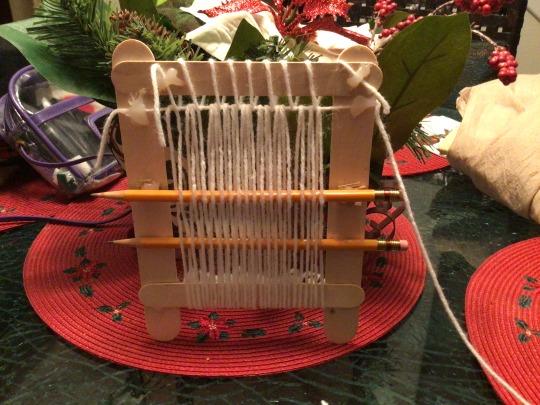
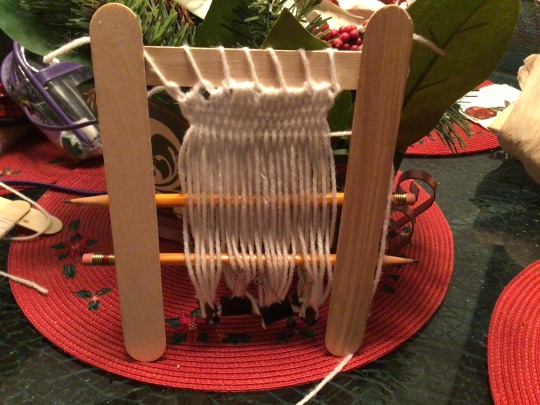
Image: Top, Two-Beam Vertical Loom, Bottom: Warp Weighted Loom.
Much of the technical aspects of the textile process only comes through archeological evidence such as weights, crystalized textiles, and surviving fragments which allows for chemical analysis. Another aspect is the way that art and literature present these processes as they tend to avoid specifics due to everyone being somewhat familiar with the process at the time.
This complex process caused many cultural ideas to form around clothing due to its ability to display one’s class. This resulted in the rapid diversification of the toga but also the introduction of sumptuary laws as clothing was seen as a reflection of the self. And so, keeping order was associated with controlling how people dress which results in banning certain dyes, textiles, and garments for specific classes.
The easiest reflection in this was the toga. The toga, as the Roman state developed, began to be seen as the quintessential Roman garment but also a symbol of freedom as only citizens can wear it. As such the toga hung around as a symbolic garment that mainly the upper classes wore or in specific ceremonies.
Another reflection was the way that women being able to weave became an aspect of the idea of the matron and femininity. Women who were able to weave were seen as desirable because it was associated with femininity and the purity that Roman men associated with the task. But this is complicated by the craftsmen who worked with textiles as they are not escalated by the workshop being a public place.
There are an endless number of aspects to how Roman culture and textiles interact and intersect. Such knowledge allows us to compare how people have viewed clothes and the ways that the Roman economy functioned. The intersection of many aspects of Classical understanding creates a more complete picture of how the Romans lived and what they left behind during the fall of Rome.
*more commonly used for paint & could only be imported from India
Sources Cited:
Ciszuk, Martin, and Lena Hammarlund. “Roman Looms – A Study or Craftsmanship and Technology in the Mons Claudianus Textile Project.” Purpureae Vestes, I, 2004, pp. 119–133.
Cleland, Liza, et al. Greek and Roman Dress from A to Z. Routledge, 2012.
Dean, Jenny. “Colours of the Romans.” Jenny Dean's Wild Colour, 23 Feb. 2015, https://www.jennydean.co.uk/colours-of-the-romans/.
Edmonson, Jonathan, and Alison Keith. Roman Dress and the Fabrics of Roman Culture. University of Toronto Press, 2009.
Gleba, Margarita, and Pászt́okai-Szeöke Judit. Making Textiles in Pre-Roman and Roman Times People, Places, Identities. Vol. 13, Oxbow Books, 2013.
Gleba, Margarita. Textile Production in Pre-Roman Italy. Oxbow, 2008.
Gleba, Margarita. “Tracing Textile Cultures of Italy and Greece in the Early First Millennium BC.” Antiquity, vol. 91, no. 359, 2017, pp. 1205–1222., doi.org/10.15184/aqy. 2017.144.
Harlow, Mary, and Marie-Louise Nosch. Greek and Roman Textiles and Dress: An Interdisciplinary Anthology. Vol. 19, Oxbow Books, 2014.
Harris, Susanna, et al., editors. Textiles in Ancient Mediterranean Iconography. Oxbow Books, 2022. JSTOR, https://doi.org/10.2307/j.ctv2npq9bb.
Herodotus. “The Histories, Book 2, Chapter 35.” Translated by A. D. Godley,Perseus Project, Tufts University, www.perseus.tufts.edu/hopper/text?doc=Hdt.+2.35& fromdoc=Perseus %3Atext%3A1999.01.0126.
Hirst, K. Kris. “What Is a Spindle Whorl?” ThoughtCo, ThoughtCo, 25 Nov. 2019, www.thoughtco.com/spindle-whorls-ancient-tool-for-weavers-172908.
Irwin, Caitlyn. “Beginners Guide to Natural Dyeing with Onion Skins.” Caitlyn Irwin, Caitlyn Irwin, 22 Jun. 2020, caitlynirwin.com/blog/beginners-guide-to- dyeing-with-onion-skins.
Melo, Maria J. “History of Natural Dyes in the Ancient Mediterranean World.” Handbook of Natural Colorants, 6 Apr. 2009, pp. 3–20., doi.org/10.1002 /9780470744970.ch1..
Mossakowaska-Gaubert, Maria. Egyptian Textiles and Their Production: ‘Word’ and ‘Object’ (Hellenistic, Roman and Byzantine Periods). Zea Books, 2020.
Plato. “Republic, Book 4, Section 429d.” Translated by Paul Shorey and William Heinemann, Perseus Project, Tufts University, www.perseus.tufts.edu/hopper /text?doc=Plat.+Rep .+4.429d&fromdoc=Perseus%3Atext%3A1999.01.0168.
Poblome, Jeroen. “Comparing Ordinary Craft Production: Textile and Pottery Production in Roman Asia Minor.” Journal of the Economic and Social History of the Orient, vol. 47, no. 4, 2004, pp. 491–506. JSTOR, www.jstor.org/stable/25165071.
Roberts, Teresinha. “Pomegranate (Punica Granatum).” Dyeing with Pomegranate | Wild Colours Natural Dyes, 19 Apr. 2021, www.wildcolours.co.uk/html/pomegranate. html.
Secundus, Gaius Plinius. “The Natural History, Book VIII, Chapter 74: Different Kinds of Cloths.” Translated by John Bostock and H. T. Riley, Perseus Project, Tufts University, www.perseus.tufts.edu/hopper/text?doc=Perseus%3Atext%3A1999. 02.0137%3Abook%3D8%3Achapter%3D74.
Tacitus, Publius Cornelius. “The Life of Cnæus Julius Agricola, Chapter 21.” Translated by Alfred John Church and William Jackson Brodribb, Perseus Project, Tufts University, www.perseus.tufts.edu/hopper/text?doc=Tac.+Ag.+21&fromdoc= Perseus%3Atext%3A1999.02.008.
Ulster Linen Staff. “From Flax to Linen.” Ulster Linen, Ulster Linen, 17 July 2018, ulsterlinen.com/flax-to-linen/.
Veitch, Jeff. “Dressmaking the Roman Way.” Lucius' Romans, University of Kent, 15 Dec. 2016, blogs.kent.ac.uk/lucius-romans/2016/12/15/dressmaking-the-roman- way/#.
Vout, Caroline. “The Myth of the Toga: Understanding the History of Roman Dress.” Greece and Rome, vol. 43, no. 2, Oct. 1996, pp. 204-220., www.jstor.org/stable/643096
0 notes
Link
Check out this listing I just added to my Poshmark closet: Gildan Ultra Cotton 100% Cotton Thirt.2000 - Black.
0 notes
Text
Glad to have visitors
先日のアンティークマーケットに来られた方(嬉しいことに私の作品を見てくださっている女性)が、友人で織りの先生と一緒にまた来てくれました。
写真中央がブライアン・ホワイトヘッドさんです。
彼はカナダ人で、現在は日本に住み、藍染めや織りをしています。また、蚕の飼育や生糸の���績も行ってい���す。
お二人とも、とても素敵な方です!
A visitor(the woman who to see my work,so I am glad) to our recent antique market came again with a friend and weaving teacher.
In the middle of the photo is Bryan Whitehead.
He is a Canadian who now lives in Japan and works as an indigo dyer and weaver. He also raises silkworms and spins raw silk.
Both of them are very nice!

彼はカナダ人で、現在は日本に住み、藍染めや織りをしています。また、蚕の飼育や生糸の紡績も行っています。
お二人とも、とても素敵な方です!
ブライアンさんを「日本文化の担い手」「日本人より日本人らしい」「日本語が上手」とは言いたくありません。
布を作ること、自分の服を作ること、糸を紡ぐこと、植物から色を取ることは、国境や人種とは関係がないからです。
ブライアンさんのインタビューを読むと、私が考えていたことと同じことを言っていました。
宮大工になろうと思っていたこと、さらには、広告のデザインをしたり、絵を描いたりしていたこと!(私は現役のグラフィックデザイナー、イラストレーターです。)
ブライアンさんのインタビュー記事
ブライアンさんのスタジオのブログ
話は戻りますが、お二人は我が家の納屋を隅々まで見て、いろいろと買ってくださいました。
自分が使いきれない糸や道具が、形にしてくれる人のところへ行くのは、本当に嬉しいことです!
二人の方に言われました。あなたも織ったらどうですか」と言われたんです。
私はとにかく何かを作るのが好きで、古布で服を作ったり紙でステイショナリーを作ったりしています。
畑では野菜やハーブを作っています。廃油で石鹸を作ったり、ハーブでお香を作ったり。私の作品にまつわるもので作っていないのは、紙と布だけかも笑。
今作っているものを極める事で、今回の人生は精一杯。
誰かが作ってくれた素敵な布や紙を、精一杯活かせるように精進します!
I don't want to say that Bryan is a "bearer of Japanese culture" or "more Japanese than the Japanese" or "speaks good Japanese. Because making cloth, making your own clothes, spinning yarns, and getting colors from plants have nothing to do with national borders or race.
When I read the interview with Bryan, he said the same thing I had been thinking.
It is the same thing that I was thinking of becoming a palace carpenter, and even the same thing that I was thinking of doing, designing advertisements and drawing pictures! (I'm an active graphic designer and illustrator)
Bryan’s interview
Bryan’s studio blog
Back to the story, the two of them looked at every inch of our barn and bought many things.
I am so glad that these threads and tools that I can't use in my life are now going to people who can give them shape!
Two people told me. They told me, "Why don't you weave too?
I really like to make something,I make clothes from old fabrics and stationery from paper.
In the field, I grow vegetables and herbs, make soap with waste oil and incense with herbs.Maybe the only things related to my work that I haven't made are paper and fabric:)
By mastering what I am making now, I am doing the best I can with my life this time.
I will devote myself to making the most of the wonderful cloth and paper that someone has made for me!
7 notes
·
View notes
Photo
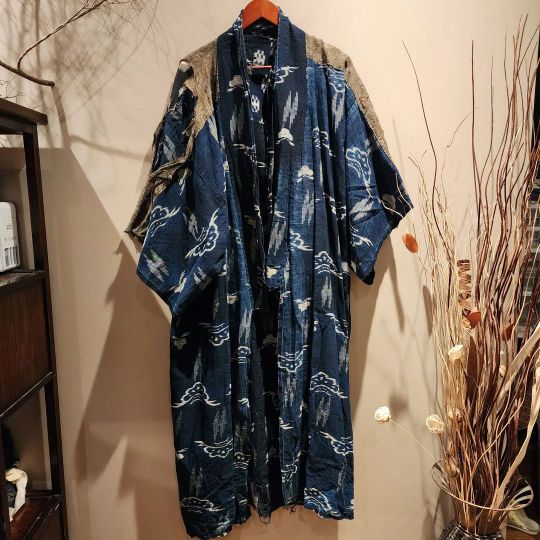
Boro Noragi updated online. Two yogi nightwear, a hemp kasuri noragi, and a reversible Patchwork workwear. A Vintage Indigo Yogi Nightwear with Kasuri weaves design pattern. This is the outer part of the original old traditional yogi garment. It was taken apart & cleaned to prep for the remaking use. Nowadays, artisans will use them to remake jackets or other garments. The original yogi was heavy and had old cotton stuffing. It is not so practical for today's use. You will find vintage nightwear like this that is just the outer layer mostly these days. In the old days, the Japanese in the countryside would use it as a blanket. Parents & their children would cuddle and sleep in these types of yogi nightwear. A vintage indigo boro noragi jacket from the early 1900s traditionally worn by peasants in rural Japan. The fabric is hemp fiber and with Kasuri woven design. #wabisabi #artpiece #vintagefashion #visvim #boro #Kapital #japaneseclothes #boroboro #downtownsquamish #vintage #antiques #museumgallery #japanesevintage #vintageindigo #patchwork #japaneseboro #japanesetextile #sashiko #costume #naturedyed #streetwear #cosplay #野良着 #fashionweek #rustic #porterclassic #bywalid #shogun #Mukashinoboro (at Squamish, British Columbia) https://www.instagram.com/p/CoiBFNEp6Yy/?igshid=NGJjMDIxMWI=
#wabisabi#artpiece#vintagefashion#visvim#boro#kapital#japaneseclothes#boroboro#downtownsquamish#vintage#antiques#museumgallery#japanesevintage#vintageindigo#patchwork#japaneseboro#japanesetextile#sashiko#costume#naturedyed#streetwear#cosplay#野良着#fashionweek#rustic#porterclassic#bywalid#shogun#mukashinoboro
1 note
·
View note